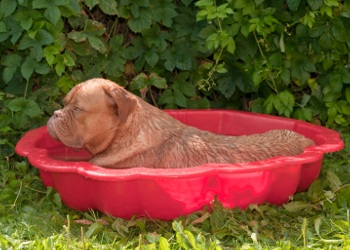Diseases #10

Cutaneous lymphoma is an extension of lymphoma. It is a neoplasia caused by mutational changes to the T or B cell lymphocytes. Lymphocytes are involved in the humoral immune response. The cause of lymphoma in the dog is unknown but any thing such as toxins, immune-mediated conditions might lead to mutations of the lymphocyte.
Lymphocytes are most commonly seen in the spleen, lymph nodes and other tissues. Hence many of the organs affected by this disease are in those locations. This is what is most commonly seen. In other cases the lymphoma is expressed on the skin surface or oral cavities. The presence of these mutated lymphocytes give rise to symptoms commonly seen in cutaneous lymphomas.
The most commonly seen signs with cutaneous lymphoma are the production of itchy, red, scaly masses on the skin. In time these can turn into hairless, inflamed plaques or nodules. These nodules can coalesce together and form one huge mass. The pressure on the skin cells is so intense that these tissues can than ulcerate and get infected with bacteria or yeast organisms.
A biopsy of the mass should be performed. That will differentiate cutaneous lymphoma from other diseases such as: bacterial, fungal or immune-mediated conditions. Radiographs or other imaging procedures should be done as well as a CBC and Chemistry Profile to assess bodily functions.
Diagnosis is only made by histopathological diagnosis once a biopsy has been performed. To differentiate between T cell or B cell lymphoma, requires the pathologist to employ different staining techniques. This is not easy to pick up all the time. It may be a part of a differential diagnosis that may be further investigated after a negative response to antibiotics is seen.
Surgical or chemotherapy treatment may be undertaken but the lesions can reoccur in other places making effective treatment difficult. Both T cell and B cell lymphomas are very difficult to treat.
The long term prognosis for cutaneous lymphoma is poor. Animals end up suffering and the quality of life is usually poor.




Demodectic Mange is transmitted to dogs via the mite, Demodex canis. It is not contagious to people. Although not as common in cats, the parasitic infestation is caused by Demodex cati.
Demodex parasites are often seen living on normal mammalian hosts. All people have Demodex sp growing on their eyelashes. It is natural and does no harm. One of my technicians once doubted me and plucked one of her eyelash hairs and looked under the microscope. Guess what she saw? What keeps Demodex sp under control is the immune system. That is why it is common in young animals since their immune system is immature. This is called juvenile Demodex. It is commonly seen in Doberman Pinschers. They are notorious for having faulty immune systems. That is why they are so susceptible to Parvo Virus. Demodex canis resides and reproduces in the hair follicle of the animal. Demodex cati does the same in cats but is always associated with some other immune-mediated disease. The parasite destroys the hair follicle hence causing associated clinical signs. Transmission is by direct contact with other dogs or cats parasitized with Demodex sp. The canine and feline versions do not cross species barriers. This means that the dog version will not spread to cats and vice versa.
Clinical signs in dogs and cats usually start around the head, face and neck areas. In young animals, small round areas of hair loss (alopecia) are seen that are initially not pruritic or inflamed. These may clear on their own. Lesions may become generalized and cause the animal to itch when a staphylococcus pyoderma sets in. The pruritis in these cases is intense.
The most important lab test is a skin scraping or hair plucking to identify the parasite under a microscope. Some cases may require a skin biopsy to diagnose the condition.
Diagnosis of Demodex sp is by identifying the organism under a microscope. Initial location and appearance of the hairless areas in the dog or cat give thought to this disease. If the animal is young that is also important to notice. All Demodex mites have a long, cigar like body with 4 pairs of limbs. Very easy to see.
Young animals with a few small areas of Demodex canis may spontaneously clear and not require treatment as their immune system matures. Some are treated with Goodwinol®, a topical preparation.
In generalized cases, a strong miticide is required. Mitaban® (amitraz) has been used for years to treat general demodicosis in dogs. Amitraz was initially used as a fruit spray in orchards! Treating this disease is very time intensive and very stubborn to eradicate. Follow the instructions on the bottle. It is very easy to overdose the animal; particularly cats. For this reason, lime sulfur dips are used on cats. Neurological signs are the most common signs seen with overdose. The dog should be bathed with benzoyl peroxide shampoo prior to dipping. The dip should never be wiped off but allowed to dry on the animal. Dips are usually done every two weeks and continued for at least 1-2 months after a negative skin scraping is received.
Ivermectins have been used to treat Demodex sp although it has not been approved for this purpose. Collies should never be treated with any ivermectin. As the old saying goes when it comes to ivermectins....."White feet, don't treat....".
Many dogs and cats have a secondary skin pyoderma and must be treated with appropriate antibiotics for weeks at a time.
The prognosis for juvenile demodex infections is excellent as they usually clear on their own. Generalized demodex infections can be difficult to eradicate but have a good prognosis if client follow through is complete. Cases of chronic demodex are almost impossible to clear or cure and have a poor prognosis.




Diabetes insipidus is not related to Diabetes mellitus. They are totally different diseases. Diabetes insipidus is not common in dogs but it can occur. The majority of cases have an unknown cause but trauma, pituitary tumors or issues with the hypothalmus have been suggested as possible causes.
There are two different types of Diabestes insipidus. Both involve issues with Anti-diuretic Hormone (ADH). This hormone regulates water absorption from the kidney. In neurological D. insipidus, the hypothalmus does not produce as much ADH as needed or faulty storage in the posterior pituitary gland. (Oxytocin is also stored in the posterior pituitary gland). In the nephrogenic version, ADH is produced but there is a faulty renal short circuit occuring that does not recognize the chemical. This occurs when the majority of renal anatomy is totally unrecognizable. Amyloid is the most common cause of that.
The hallmark signs of Diabetes Insipidus are: increased thirst and urination plus production of an extremely dilute urine; almost close to the specific gravity of water. Many animals may not be able to hold their urine and may urinate in the home or their bedding.
Lab work is needed to differentiate Diabetes insipidus from other causes of excess thirst and urination. These are: Diabetes mellitus, Cushing's Syndrome plus renal and liver disease. A CBC, Chemistry Profile and urinalysis are performed. A specific gravity of almost 1.000 is suspicious and a water deprivation test is performed. Water is withdrawn for a predetermined period and the specific gravity of the urine is checked. In normal dogs, the specific gravity is higher since water is scarce and the urine is more concentrated. In Diabetes insipidus, the specific gravity is unaltered; almost close to 1.003 or so. More specific tests such as ADH levels may be performed.
A diagnosis of Diabetes insipidus is made based on: history, clinical signs plus all laboratory work performed needed to diagnose Diabetes insipidus but rule out other causes of excess thirst (polydipsia) and excess urination (polyuria).
Diabetes insipidus can be treated successfully but not cured. In all dogs vasopressin tannate (synthetic ADH) can be administered by injection or by intranasal drops.
The prognosis for most cases of Diabetes insipidus depends upon the organ effected. Although it can be treated, the prognosis in the central version depends upon the severity and or stabilization of the hypothalmus. In nephrogenic cases the prognosis is dependent upon the pathology associated with renal disease. Every case is different hence a prognosis will vary from animal to animal.




Diabetes mellitus is caused by an insufficient production of insulin in the beta cells of the endocrine side of the pancreas. The pancreas also is made up of other cells that manufacture enzymes used in the digestive system. In cats, a transient Diabetes mellitus is often caused by the administration of estrogens such as Ovaban® that were once used to treat feline miliary dermatitis.
Many dogs develop Diabetes mellitus after a severe bout with pancreatitis. This is most commonly seen in Miniature Schnauzers. These animals have a history of eating trash which causes the pancreatitis and soon after, clinical signs of Diabetes mellitus.
Diabetes mellitus is very common in dogs and cats. The main function of insulin is to facilitate the transfer of glucose into the cell where it is metabolized for cellular functions. This process is slowed down by excess fat around the cells. Diabetes is grouped into two groups. Diabetes type 1 is the typical insulin dependent type while Diabetes type 2 is non insulin dependent. In humans the latter are often treated with drugs that stimulate insulin production such as the sulfonylureas. These do not work in animals. Obese animals suffer from this but all of them require some form of insulin for control. In cats, type 2 is also the prevalent type of Diabetes mellitus.
The classical signs of Diabetes mellitus are: weight loss, tired and reluctant to exercise, excess appetite plus excess thirst and urination. Dogs will develop diabetic cataracts that are seen early in the disease. The owner may report a cloudiness in the eye itself. Owners may also report that, if the animal has urinated in the home on a tile or wood surface, the urine appears sticky.
A CBC and Chemistry Profile must be done. This will give the level of sugar in the blood. Most diabetics will have a blood sugar reading of 400 and up. Some, as high as 800! A complete urinalysis is done. All diabetics will have sugar spilled into the urine. The kidneys can only handle about 200mg/dl of glucose. Over that, it is "spilled" into the urine. This is picked up by a urine dip stick. It will also detect any ketone bodies. Ketones are the result of fat metabolism. If glucose can not be metabolized for energy than fat will be next. Excessive metabolites of fat metabolims known as ketones will be spilled into the urine. If the levels are ultra high, the animal may be ketoacidotic; a severe form of Diabetes mellitus with acidic byproducts present (ketones).
The diagnosis of Diabetes mellitus is made by the history of clinical signs seen by the owner and by physical findings and lab work performed by the veterinarian. The majority of dogs afflicted with this disease are small dogs. Poodles, Maltese, Miniature Schnauzers, Dachshunds and Pugs are commonly diagnosed. About 10% of dogs diagnosed with Diabetes Mellitus are also Cushingoid. No one has figured out which comes first. Sort of like the chicken and the egg analogy. These animals are often diagnosed when the dose of insulin gets to about 2 units per pound to control the blood sugar.
The goals of therapy are to introduce sufficient insulin into the body so as to bring blood sugar down to about 125 mg/dl. If this is accomplished and stabilized, clinical signs will abate. Dogs and cats are administered insulin twice a day. Treatment of diabetes requires a personal and financial commitment to the animal. If the owner goes on vacation, it is recommended that the animal be boarded at the medical facility where staff can administer the insulin and keep an eye on the animal. Numerous types of insulin may be used. Suspensions such as PZI, NPH and lente are commonly used. Solution insulins such as Glargine and Detemir have been used. In cats, the goal is remission of clinical signs. Up to 50% of them will end up in remission. More expensive versions of insulin will lead to a quicker remission. Vetsulin® is relatively cheap but there is a lesser chance of remission on it.
There can be problems with the insulin, operator error or physiological changes in the patient. Changing insulin injection sites is important. If an owner thinks he or she missed the insulin dose DO NOT REPEAT IT! Retest the urine the following day and administer the insulin dose. Giving an extra shot of insulin to a dog that already actually got the shot, will lead to a crash in the dogs blood sugar. Signs such as staggering, glassy eyes and stupor are most common. Animals can easily be brought out of this by smearing KaroSyrup® (light colored version) into the mouth and oral cavity. This is found in the local supermarket. Erratic absorption, excessive exercise or poor diet will make blood sugar readings more erratic.
Dietary control is important. Food should be available to the dog early in the morning. The remainder of the food is than administered at the peak time of insulin activity; usually about 6-8 hours after injecting the insulin. There are excellent diets on the market used to manage diabetes mellitus. Hill's Prescription Canine w/d, Hill's Prescription Feline w/d and Purina® Feline DM are good diets.
If Cushing's Syndrome is diagnosed after the animal is on insulin, Trilostane is commenced to treat the Cushing's and the insulin dose is cut by anywhere from 25%-33%. By treating Cushing's, the secondary cortisol induced hyperglycemia will naturally lower. If you add the same dose of insulin to the mix, the dogs blood sugar will crash.
Day to day insulin dosing is often done by testing the urine. An excellent photo display of this technique is available in the "Learn More" section. Taking a dog out to urinate on a leash in the morning and putting a plate underneath to catch urine is pretty easy. Most diabetic cat owners always gave me that blank stare when I told them to get a sample from their cat. The easiest way to obtain cat urine is by using Kit4Cat®. This is a hydrophobic type of sand. The urine pools on the surface so a Diastix® or KetoDiastix® strip can be dipped into the urine.
Management of the diabetic patient also requires numerous physical exams and actual blood glucose readings performed at the peak of the insulins action. Periodically, the animal will be hospitalized to perform a glucose tolerance test where blood is drawn every hour throughout the day after the morning insulin injection. This data is plotted on a graph and interpreted.
Anything can happen to diabetics at any time and many of these problems will occur after hours or on weekends. It is imperative that owners have a local emergency clinic to go to in their area or the telephone number of their veterinarian that accepts after hours emergency calls.
The prognosis for the maintenance of most diabetic patients is quite good. It entails a lot of work on the part of the owner but it can be rewarding. Client education is the key. Understanding the disease and how it is treated helps all concerned. Recognizing when to seek medical attention is crucial for long term survival of the patient. The prognosis for advanced diabetics suffering from ketoacidosis is guarded at best.




Diarrhea is one of the most common diseases in dogs and cats. It produces the greatest consternation in owners also. They want their pet to get better but do not want that new carpet or sofa damaged. Diarrhea is classified in several ways. The easiest to remember is diarrhea of the small intestine and diarrhea of the large intestine. The former will be runny, watery, and can be dark colored due to blood that is broken down in that area. Diarrhea seen in the large intestine is often soft, mucousy and may contain red flecks of blood surrounding the stool. The causes of diarrhea are many: intestinal parasites, maldigestion, malabsorption, pancreatitis, liver disease, change of diet, giving cow's milk to an animal, eating spoiled or spicy foods, secondary to heat stroke, immune-mediated as well as the more common bacterial or viral infections.
Regardless of the cause, diarrhea acts the same way. In small intestinal diseases, the cells lining the digestive tract becomes sick and often die. This leads to malabsorption and maldigestion in the small intestine. The effect of this irritates the lining and increases the motion or gut motility. This leads to diarrhea. In the large intestine, irritation to the colonic mucosa leads to less water absorption in the area. The lower bowel is where most water is naturally reabsorbed into the body. This leads to increased motility and diarrhea from the large colon.
The most common signs are the production of a watery or loose stool with or without blood present (melena). Dogs are uncomfortable and may attempt to defecate and or strain to defecate more frequently. In severe cases, dehydration occurs. A few animals will vomit. In cats, this observation can be misleading. Yes, cats do develop diarrhea but many times a client will see a cat straining thinking it is either constipated or has diarrhea. In fact, many of these cats are straining to urinate due to a urethral obstruction. Constant straining in cats should immediately be evaluated by a veterinarian.
All animals with diarrhea should have a complete workup. Young and tiny small animals are at a greater risk of dehydration when compared to a larger adult animal. For this reason, a CBC and Chemistry profile should be done. The hematocrit almost always shows some sort of a dehydration profile. Electrolyte losses can be determined via the Chemistry profile. Radiographs may be taken to look for gas distended intestinal loops as well as potential foreign bodies. A fecal exam is always taken to check for intestinal parasites. Since there are a myriad of causes of diarrhea, other tests may be performed as dictated by history and clinical signs. Most adult pets should be screened for acute pancreatitis. This can be done in house using the Idexx® cPL Snap Test in the dog and the Idexx® fPL Snap Test in the cat.
Diagnosis of diarrhea is made by history of a loose or water diarrhea that may or may not have blood in it. Results of a physical exam and all lab work put together attempts to find the causative agent of the diarrhea. Sometimes the diagnosis is unknown (idiopathic) so all one can do is treat the symptoms and reevaluate the patient at a later date.
The treatment of diarrhea is geared towards finding the cause of the diarrhea, reversing the clinical signs plus providing fluid therapy to the majority of patients. If an animal is suffering from diarrhea caused by Parvo virus, that dog is likely to be hospitalized. Mild diarrhea caused by parasites is treated on an outpatient basis.
The most important therapy is fluid therapy. Animals that are lightly dehydrated can be given subcutaneous fluids while being treated for the primary disease. Severely debilitated and dehydrated animals are hospitalized and fluids are administered intravenously. The goal of fluid therapy is to take care of the fluid deficit than switch to maintenance mode to insure the functioning of crucial organs such as the heart and kidneys. Antibiotics are often given to patients. Regardless of the cause, native bacterial flora is out of whack. The good guys have been killed at the expense of the bad guys. Antibacterials are often needed to bring this ratio back in check. Symptomatic care of diarrhea is done via the use of aminopentamide. This drug is superb for the treatment of hypermotility in dogs and cats. Diarrhea causes a lot of visceral pain. It hurts. Butorphanol is often given to decrease the pain plus encourages the patient to rest. Dietary control is important. Owners can make up their own recipe of chicken and rice at a 1:3 ratio and feed small amounts of it at a time throughout the day. Owners may also purchase the appropriate dog or cat version of Hill's® Prescription i/d food. Animals do well at home with sports drinks. They like the taste and they replace electrolytes lost in vomiting and diarrhea. Sports drinks can also be frozen in an ice cube tray and put in the animal's water bowl (without water). This quenches thirst without over consumption of water.
The prognosis for the myriad causes of diarrhea is dependent on the cause but the majority of them have a good prognosis if diagnosed and treated early. The key is prevention in many instances. If your dog loves to go dumpster diving, elevate the trash can so the dog can not reach it. Do not give your dog cows milk. If you change your pets food, do it gradually. Mix it in about a 50:50 ratio and over time increase the amount of food you wish the animal to eat. Since many cases of diarrhea are seen in young animals always make sure the puppy is checked for intestinal parasites and current on vaccines. Some dogs are just prone to diarrhea. As they age, German Shepherds are prone to exocrine pancreatic disease and are usually put on a powdered enzyme supplement like Viokase®.

